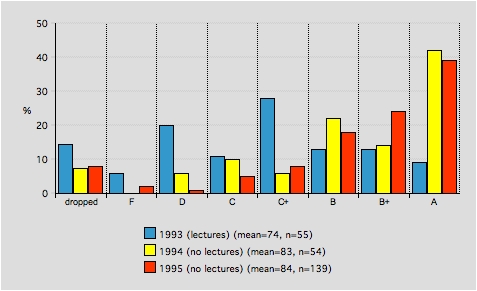Abandoning the lecture
Evans & Omaha Boy (1996) describe an investigation of a biology unit that had been taught at Rutgers University using lectures (there were no lab sessions) for many years but was then conducted in a lecture-free mode.
Learning was guided by a workbook containing reading assignments, other materials to clarify concepts, work sheets and self-tests that concentrated on concepts rather than ‘facts’.
Motivation is very important to the success of this form of teaching so ‘The instructor made a considerable effort to create a positive attitude among the students toward the guided learning format’ (pp. 97-98).
Small tests were held every week with feedback delivered immediately, allowing students to undertake an optional second test, the better of the two scores being recorded. There was a final, comprehensive exam. Prior to the abandonment of lectures, assessment had been by 4 tests, evenly distributed through the semester with no overlaps of content.
In 1994, classes (50 students) were run in a single session, broken into the following parts:
Q&A session:
30 mins
Test 1: 45 mins with immediate feedback
Q&A session: 40 mins
Test 2 (optional): 45 mins with immediate feedback
In the following year, classes (139 students) were run over two days:
Tuesday
Q&A session: 30 mins
Test 1: 45 mins with immediate feedback
Thursday
Test 2 (optional): 45 mins with immediate feedback
Mini-lecture to introduce next week’s material (optional): 30 mins
The mini-lectures conducted in 1995 were held in response to some students’ requests for lectures for reinforcement or overview. Although attended by few students, these students highly valued the sessions.
The change allowed more efficient use of the class time because it allowed concentration on areas of difficulty. The teacher’s role changed to that of a facilitator.
The student-satisfaction ratings (6 criteria) either rose or remained static (averaging around 4.6 out of 5) relative to the lecture-based unit which itself already had markedly higher ratings (averaging 4.5 out of 5) than other first-year units offered by the institution (averaging 4.0 to 4.2 out of 5 over the study period).
There were several improvements in general study habits with the students showing better approaches to study, independent learning habits and greater confidence. These changes were reflected in the assessments.
Assessment performance also improved relative to the lecture-based unit:
* class average rose from 74 to 84%
* grade A students increased from 9% to 40%
* fails decreased from 6% to 2%
* dropouts decreased from 15% to 8%
The improvement in grades was not biased by the introduction of continuous assessment: the marks for the final, comprehensive exams were higher than those from the lecture-based unit.
Evans, R.C. & Omaha Boy, N.H. (1996). Abandoning the lecture in biology. J. Excellence in College Teaching 7(3): 93-110. Abstract available online.
Comments
1. The demand for and appreciation of the mini-lectures by a few students is indicative of different learning styles.
2. The move to splitting the material over two days was potentially advantageous for learning except that the second day’s materials were optional so that only the motivated students would undertake the second (optional) test.
3. Alternatively, the second test could have started the following week’s session, encouraging students to take it.
4. It was hard to demonstrate a huge improvement in student satisfaction because this was high even for the lecture-based unit: one of the dangers inherent in good teaching!
5. The importance of motivating the students was emphasized. It is incorrect to assume that the class is self-motivated or motivated by the intrinsic nature of the content. It is up to the teacher to motivate the students and this is a very important factor in successfully teaching – especially when the methodology demands ongoing commitment from the students. This motivation can come in a number of valid forms that are highly dependent on the teacher. Of course, this makes the outcomes more sensitive to the teaching style. So, teaching without lectures demands a strong commitment from the teaching staff to students’ learning.
6. It would be interesting to know what further changes have been made since the advent of the Internet into teaching.

